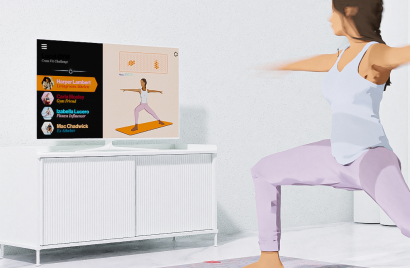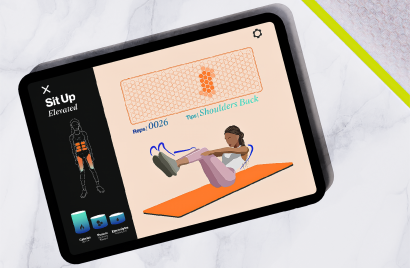
Dr. Martens champions sustainable fashion
Genix Nappa, a new material made of leather offcuts, aims to reduce waste

Emma Caselton, Senior Creative Strategist at Seymourpowell explores how the UK rediscovered the joy of exercise, and how technology is helping to define the notion of what a gym looks like.

Six months on from the day the UK entered its first full scale lockdown, and it seems we are still no closer to a return to normal. If anything, we are anticipating what our ‘new normal’ looks like, as opposed to a return to our previous state of existence.
There is not a sector that hasn’t been directly impacted by this virus, and so it is important to consider how COVID-19 is not only impacting our societal structures, but also how it is going to redefine the way in which we live. At Seymourpowell we have been exploring these changes through our 66 Days of Change survey, a study of 250 respondents which has highlighted a number of areas which are being impacted most and are in need of a rethink as a result. One of those sectors is exercise and the gym environment.
The future gym will be built around the people that attend it, however that happens.
Emma Caselton
During the national lockdown and throughout this period of uncertainty and constant change, the UK has rediscovered the pleasure of exercise. In response to our survey, 34% of participants said that doing more exercise was one of the nicest things to come from lockdown, and when asked which activities they would do more of in a post-pandemic world, 50% of our respondents answered exercising outside.
In reverse, however, those statistics could show that many people have been disengaged with exercise. As it was before lockdown, people still find staying fit a challenge. Not everyone is naturally predisposed to running or cycling, and many find gyms intimidating. With the combination of lockdown and the pandemic showing exercise to be ever more crucial for physical and mental health, how can we help people overcome these challenges? Given that 955,185 YouTube viewers, both adults and children, streamed Joe Wicks’ #PEwithJoe one morning during lockdown, is the home part of the solution?
With travel restricted, we have found ourselves confined to our homes and local areas. For those people who find that exercise already plays a significant role in their lives, the home, along with the outdoors and the gym, represents a viable addition to their fitness options. When Stylist Magazine asked their post-lockdown readers about their exercise regime, 80% said that, rather than heading to the gym every day, they would keep some home workouts as part of their plan.
However, exercise at home has always felt compromised. Besides negotiating the furniture, the experience lacked soul and variety. With exercise videos, the fake ‘class’ doing it with you in the background was no substitute for the camaraderie, drive and competition of real-life people. The same programme day-in-day-out was monotonous. The absence of a real instructor meant you may or may not be getting it right. And most importantly, the social element of classes was absent. Connectivity has changed this.
The idea of the gym can reach beyond the traditional location and can be made available in the home as a rich and viable part of people’s fitness regime.
With this in mind, we should consider how we can connect the gym and home workout arena. How can technology support it? How can it provide a truly connected experience to maintain the social aspects of the gym that people enjoy so much?
At Seymourpowell, we have envisioned how technology can help bring the excitement of exercise back into our lives. Imagining a social platform that is centred around a smart gym mat, we could utilise data gathered from users to provide a truly connected experience.
The mat’s network of sensors measures an individual’s position, weight, speed and power, and allow us to tap into the potential for cloud computing and AI. With this data, a digital twin can be created, helping to visualise our performance, advise on how we perform, and be used by a trainer or coach.
Providing more than just access to coaching advice, the virtual connection also brings depth to the home gym. Taking inspiration from entertainment platforms like Dice, gyms could broadcast live, one-off sessions. The credibility of these experiences would be rooted in the personalised advice that the coach can provide, using the feedback from the smart mat and the digital twin. Tapping into audiences that mix up their gym experiences by using apps like Classpass, guest coaches could form the core of exclusive, ticketed, social gym events. This experience can become a social one; that allows you to have the interactions that many crave from a fitness class and, more importantly for some, team mates to compete with and challenge.
To think about the bigger ecosystem as it filters into the home, the future gym could help to manage our sleep patterns and offer services for our mental well-being. Breaking free from the nomenclature that binds it to its location, the future gym will not be a place. The future gym will be built around the people that attend it, however that happens. It will be a club that, through a network of hardware, software, services and members, engenders a 360-degree approach to health and fitness.


With an MA in Design Products from the Royal College of Art, Emma’s experience spans across product, packaging, transport and interior. At Seymourpowell she enjoys the discovery in developing new ideas, the reward of improving consumer’s lives, and the challenge of helping businesses explore and grow their potential.
Looks like you need to create a Creativebrief account to perform this action.
Create account Sign inLooks like you need to create a Creativebrief account to perform this action.
Create account Sign in